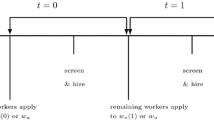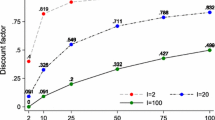Abstract
Directed search models labor markets where workers observe wages before deciding where they will apply. This paper tests this model for the case of heterogeneous firms in a laboratory experiment. The theory predicts that more productive firms offer higher wages and workers apply more often to these higher wages. In consequence, more productive firms are more likely to match and the market is more efficient than the prediction of an alternative model where search is random. The main results of the experiment are that average firms offer wages that are close to or a little lower than the theoretical predictions but highly variable and workers apply more often to high offers but not to the extent predicted. The markets are no more efficient than random search predicts, because of the variation in wage offers.




Similar content being viewed by others
Notes
Most other models of directed search have continuums of workers and firms which is not implementable in the laboratory but have similar implications.
More generally, there are n firms and m workers. For simplicity, the model will be presented with the group size, five, that was used in the experiment.
There are many equilibria of the game. However, as the workers are identical with no means to communicate, it is generally considered implausible that workers could coordinate on an asymmetric outcome.
The uniqueness of the solution to the workers’ problem makes the following problem well-defined. When the symmetry assumption is dropped, the equilibrium possibilities are greatly expanded as the firms may believe the workers will play different equilibria of their coordination game for different wage offers so many “trigger” equilibria may exist.
Directed search equilibria are usually constrained efficient, but this one is not due to the combination of finite players and heterogeneity. For the parameters in the experiment, the equilibrium is only about 1 % away from the constrained efficient outcome so it is very close to constrained efficient.
See Ochs 1995b for an example.
The bins are defined by the predicted probabilities. Bin 1 includes applications to all wage offers where the predicted probability is in (0.5,0.5), bin 2 includes applications to all wage offers where the predicted probability is in (0.55,0.6), etc. up to (0.95,1).
All the standard errors for means in the paper are calculated with random effects dummy variable regressions with robust standard errors. The standard errors have also been calculated with OLS and clustering and these errors are very close to the ones reported in the paper.
The results also do indicate that workers do not learn over the course of the experiment, a result that is not true for firms.
Learning takes fewer periods in the second treatment in each session. This is the only significant difference that comes from the within session design.
This statement stems from an earlier version of the paper and is based on a model of worker behavior that is not developed here.
There is no statistical analysis in this section because matching is not a choice, but rather an outcome of choices that have already been compared with equilibrium in the analysis above.
The number .025 is chosen to be consistent with the size of the bins in Fig. 1, but can be changed without altering the argument.
References
Abrams, E., Sefton, M., & Yavas, A. (2000). An experimental comparison of two search models. Economic Theory, 16, 735–749.
Burdett, K., Shi, S., & Wright, R. (2001). Pricing and matching with frictions. The Journal of Political Economy, 109(5), 1060–1085.
Cason, T., & Friedman, D. (2003). Buyer search and price dispersion: A laboratory study. Journal of Economic Theory, 112(2), 232–260.
Cason, T., & Noussair, C. (2007). A market with frictions in the matching process: An experimental study. International Economic Review, 48(2), 665–691.
Cassar, A. (2007). Cooperation and coordination in local, random, and small world networks: Experimental evidence. Games and Economic Behavior, 58(2), 209–230.
Cassar, A., & Rigdon, M. (2011). Trust and trustworthiness in networked exchange. Games and Economic Behavior, 71(2), 282–303.
Charness, G., Corominas-Bosch, M., & Frechette, G. (2007). Bargaining and network structure: An experiment. Journal of Economic Theory, 136, 28–65.
Corbae, D., & Duffy, J. (2008). Experiments with network formation. Games and Economic Behavior, 64(1), 81–120.
Davis, D., & Holt, C. (1996). Consumer search costs and market performance. Economic Inquiry, 34, 133–151.
Deck, C., & Johnson, C. (2004). Link bidding in a laboratory network. Review of Economic Dynamics, 8(4), 359–372.
Fischbacher, U. (2007). Zurich toolbox for ready-made economic experiments. Experimental Economics, 10(2), 171–178.
Grether, D., Schwartz, A., & Wilde, L. (1998). Uncertainty and shopping behavior: An experimental analysis. The Review of Economic Studies, 55(2), 323–342.
Grosskopf, B. (2003). Reinforcement and directional learning in the ultimatum game with responder competition. Experimental Economics, 6(2), 141–158.
Guth, W., Marchand, N., & Rulliere, J. L. (1997). On the reliability of reciprocal fairness: An experimental study. Berlin: Wirtschaftswissenschaftliche Fakultät.
Menzio, G., & Shi, S. (2010). Block recursive equilibria for stochastic models of search on the job. Journal of Economic Theory, 145(4), 1453–1494.
Menzio, G., & Shi, S. (2011). Efficient search on the job and the business cycle. Journal of Political Economy, 119(3), 468–510.
Moen, E. R. (1997). Competitive search equilibrium. The Journal of Political Economy, 105(2), 385–411.
Montgomery, J. D. (1991). Equilibrium wage dispersion and interindustry wage differentials. The Quarterly Journal of Economics, 106(1), 163–179.
Ochs, J. (1995a). Coordination problems. In J. Kagel & A. Roth (Eds.), Handbook of experimental economics (pp. 195–249). Princeton: Princeton University Press.
Ochs, J. (1995b). Games with unique, mixed strategy equilibria: An experimental study. Games and Economic Behavior, 10(1), 202–217.
Ochs, J. (1990). The coordination problem in decentralized markets: An experiment. The Quarterly Journal of Economics, 105(2), 545–559.
Peters, M. (1991). Ex ante price offers in matching games non-steady states. Econometrica, 59(5), 1425–1454.
Roth, A., Prasnikar, V., Okuno-Fujiwara, M., & Zamir, S. (1991). Bargaining and market behavior in Jerusalem, Ljubljana, Pittsburgh, and Tokyo: An experimental study. The American Economic Review, 81(5), 1068–1095.
Shi, S. (2009). Directed search for equilibrium wage-tenure contracts. Econometrica, 77, 561–584.
Acknowledgments
I wish to thank Andrew Schotter and Guillaume Frechette for their help on this project as well as numerous others for insightful comments. Also, thanks to the Center for Experimental Social Science for financial support. Finally, I also thank participants at the CESS-CREED Graduate Student Conference 2011, the North American ESA Conference 2011, and the matching workshop at the Philadelphia Federal Reserve Bank in May 2013.
Author information
Authors and Affiliations
Corresponding author
Electronic supplementary material
Below is the link to the electronic supplementary material.
Rights and permissions
About this article
Cite this article
Kloosterman, A. Directed search with heterogeneous firms: an experimental study. Exp Econ 19, 51–66 (2016). https://doi.org/10.1007/s10683-014-9426-8
Received:
Revised:
Accepted:
Published:
Issue Date:
DOI: https://doi.org/10.1007/s10683-014-9426-8




